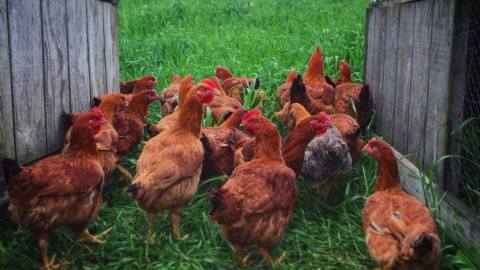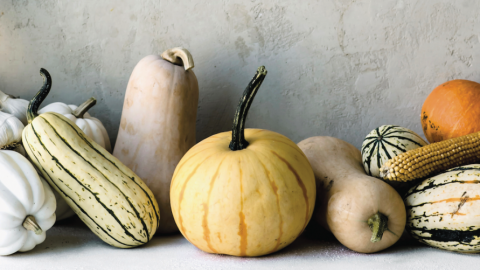A Local Farmer's Reflections on the Impact of COVID-19
On a livestock farm, March is never a pleasant month. It’s a time of endless mud, the occasional snowstorm, slow farmers markets, dwindling bank accounts, and a gnawing eagerness for a glimpse of something – anything – green and growing. But every year has its March, and every year, the farmer can plan and cope and muddle through ‘til spring. No farmer, however, had planned on the global pandemic that would make this March so bitterly memorable.
Life on a farm, of course, can be surprisingly insulating, and as COVID-19 began its spread from China, through Italy, to Washington state and California and New York City, life continued on as always. There was hay to feed out, water troughs to fill, eggs in need of collecting, and the rising unease, palpable though it was, felt distant. And then, almost in the space of a single week in early March, COVID became alarmingly real.
The initial outbreak in New York was close enough to send ripples through rural Litchfield County, where I raise cattle, pigs, and chickens, and masks began appearing, as restaurants were ordered shut. Chaos and uncertainty became as omnipresent as the March mud. The shuttered restaurants abruptly cut weekly orders, which for us amounted to the end of regular egg deliveries. Then, our chief source of winter income, a weekly New Haven farmers market, closed down, necessarily but abruptly. No one – not chefs, organizers, or officials – had any sense of how long the closures would last.
Yet, if there was any sort of silver lining to those first days of crisis, it was the newfound attention that people were suddenly forced to pay towards food and its availability. After years of declaiming the fragility of the industrial food system to only modest effect, small-scale farmers were, at last, proven correct. Eggs vanished from grocery stores, along with toilet paper and hand sanitizer. The gears of the massive Midwest slaughterhouses ground to a halt, as working conditions became every bit as unsanitary as the feedlots. Millions of hogs and meat chickens, with no place to be processed, were euthanized. Shelves emptied and, for a brief moment, panic set in.
From that panic, a new appreciation for local food seemed to bloom. Chest freezers sold out, as people rushed to stock their houses against another shortage. Requests for halves or quarters of beef and pork increased, as did CSA share buy-ins. Our Saturday market reopened as an order-only, drive-through operation: customers would submit online orders during the week, which we’d then deposit in the trunks of their cars, as they slowly progressed from vendor to vendor. In those first weeks back, sales increased dramatically beyond what was normal for the season. Although the order-ahead hoops we were jumping through were extensive, and the atmosphere was one of fear and paranoia, income, at least, was flowing once more, at a time when it was sorely needed. Even that new normal, however, wouldn’t last.
The reality was that we were operating at full capacity in what should have been an off season. Our sales were coming from the stocks of beef, pork, and chicken we had kept over from the previous fall. Those reserves were supposed to last until at least June, when the advent of summer meant we could start harvesting animals again. But we were selling product far faster than we’d ever anticipated, and we began to run out of items. Eggs were in far, far greater demand than ever, but the hens only produce so many dozen a day. Increasing the size of the flock was something that would take weeks or months before showing a benefit. We began rationing egg sales, and then ultimately only sold them along with the purchase of meat, to at least keep our most-dedicated customers satisfied. Pork supplies, too, were low, but our hogs weren’t scheduled at the slaughterhouse for weeks. And without spring’s first grass to fatten up our steers, grass-fed beef was hardly at its prime. Our resources were finite, tied inextricably to seasonality, and we couldn’t magically refill our freezers overnight. Without more product, our initial bump in sales fell off precipitously by May.
COVID also shed a light on just how limited our local food infrastructure truly is. Here in Connecticut, there are only a handful of USDA-approved slaughter facilities, not all of which accept all species, and none of which process poultry. For years, they had more or less kept up with local farmers’ needs, provided one planned ahead or was willing to travel. But as the virus hit, it seemed that the problems of the industrial system caused a production cascade, as desperate growers sought any available slaughter facility for their livestock. Eventually, that cascade even reached small, local operations, and by the end of April, it was impossible to get an appointment for a steer at a USDA-regulated facility before next winter.
While a few months lead time was to be expected, scheduling three quarters of a year in advance was a hurdle most small farmers hadn’t anticipated. On our farm, we turned to on-farm slaughtering, putting our cattle down in the field before having them processed in a local butcher shop. While that forgoes the flexibility of having a USDA stamp, it still allows us to offer quarter, half, or whole animals for sale, and keeps our personal freezer full in uncertain times. There’s also been earnest discussions among some farmers about civil disobedience and ignoring the strictures of a USDA label in order to get their product to waiting customers. The thinking is that, if the system is so skewed towards industrial agricultural interests, so flawed and so fragile, then maybe it deserves to be broken or, at least, ignored.
When COVID first struck, the common sentiment seemed to be that it would abate by summer and would, hopefully, be under control before long. I doubt many farmers shared that optimism. In farming, you learn to expect adversity, and you learn to take the long view. You become used to dealing with stubborn, recalcitrant animals who obstinately refuse direction, even when you have their well-being in mind. You anticipate that things will get worse before they get better. Even now, in the midst of an epidemic, the farmer has to look ahead to the next spring and the next summer and the next fall, and envision what could go wrong. We may see another burst of interest in the food we provide, and though the recent spike in customer traffic is appreciated, the years of consumer neglect that led up to it created a situation in which farmers’ food stocks simply were not prepared for a sustained increase in sales. Had consumers regularly and willingly supported local livestock farmers in recent decades, then perhaps the story would have been different; perhaps, it would have been “business as usual,” at least in terms of meat and egg availability for consumers. And, perhaps, there is a future in which local livestock farmers really will be the primary meat source for our communities, but to get there, consumers need to commit to consistently supporting small-scale, ethical farm operations. If customers turn to cheaper, industrially farmed meat sources when the epidemic abates, it seems less and less likely that any of us will be here to provide food for the next one.











